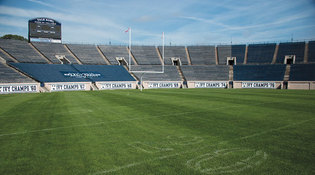 loading
loading
Light & VerityArtificial turf for the Bowl?Replacing the natural grass would have advantages, but some have raised health concerns.  Mark Zurolo ’01MFAThe Yale Bowl has one of the two remaining natural-grass fields in the Ivy League. View full imageThe Yale Bowl, preserved in nearly its original form for 101 years, is a kind of shrine to old-school football. But the pressures of modern college athletics affect even Yale. Case in point: the news, first reported in the Hartford Courant in August, that the university plans to replace the Bowl’s natural grass field with artificial turf. The conversion to artificial turf is a requirement for another change: a 65-foot-tall bubble roof that could be installed over the playing field during the off-season. Yale athletics officials have not confirmed that the department is moving ahead with the plan for new turf and a bubble; Alison Cole ’99, deputy director of athletics, says only that Yale is “exploring this project.” Of the eight Ivy League schools, only Yale and Brown have natural fields, and advocates say the changes would improve competitiveness. Harvard and Princeton both use “practice bubbles” during the winter. As for the turf, says head football coach Tony Reno, drainage and maintenance of the current field is difficult because the Bowl’s field is sunken and sits near sea level. As a result, the field is often in rough shape by the end of a season, torn up and littered with divots. “If the university does allow us to put a field surface and [bubble] in,” says Reno, “we could play on a consistent surface and train year-round.” The bubble could transform the Bowl into a practice facility for other teams or an alternate site for games—a potential boost to spring squads, such as baseball, that must often travel south to compete during February and March. “I can’t imagine how hard it is for our baseball and lacrosse and softball teams having to go into the season with half a foot of snow on the ground,” says Reno. Athletic officials also say the bubbled Bowl might serve as a new venue for residential college intramurals. But a local environmental group has spoken out in opposition to the plan. In a New Haven Register op-ed, members of Environmental and Human Health—including five Yale doctors—argued against artificial turf, saying that it would compromise the character of the Bowl (a National Historic Landmark) and put players’ health at risk. They cited a recent study completed by Gaboury Benoit ’78, professor of environmental chemistry and engineering at the School of Forestry and Environmental Studies, which detected 96 chemicals in samples of rubber tire infill used in artificial surfaces. Twenty percent of the chemicals were considered carcinogens and 40 percent were skin and eye irritants. “Unless and until I see that there are limited health risks associated with these toxic compounds, I would be against” turf, says Benoit. “I have a couple of teenage kids—I would certainly discourage them from playing on such fields.” Regardless of what happens on the field, one historic change is definitely on the way. Temporary lighting will be installed in the Bowl for this year’s game with Harvard, which will begin at the unaccustomed late hour of 2:30 p.m. and end after sunset. The start time is an accommodation made for cable TV’s NBC Sports Network, which will televise The Game. It will be the first time football has ever been played under lights at the Bowl.
The comment period has expired.
|
|